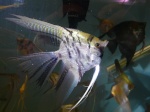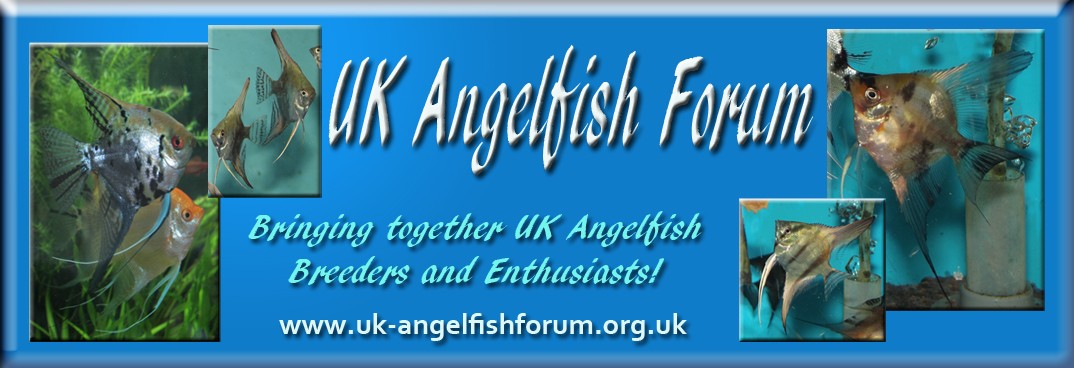Latest topics


Every shade of blue
+4
uk bulldog
endlessendlers
Ghipsi
Pterophyllum
8 posters
Page 1 of 1
 Every shade of blue
Every shade of blue
It has long been the goal of many angelfish breeders to produce a blue angel, and the name blue has been applied to a number of different varieties.
In the early 70's German breeders working with the stripeless gene, produced blushing angels with a very subtle shade of blue (so subtle that except in the very best specimens it was hard to see at all!) these were refered to as German blue blushing or sometimes German Blues.
Other breeders working with the blushing gene produced blushing black lace angels (D/+ - S/S) which they called "blue" angels, whilst Double dark blushers were called, I believe, "purple angels".
Others crossed "German Blues" to "Koi" angels to produce "Blue koi" (Gm/+ - S/S)
Then, back in the early 1990's a new colour angelfish appeared, although it wasn't until the early part of this century that they started to appear in the UK. This colour was platinum, a bright white fish, often with just a hint of blue, particularily in the striations of the dorsal fin.

No doubt the breeder had some inkling as to the genetics behind this stunning new variety, but who first developed them and exactly what they understood of their genetics, is not known.
For several years there was considerable argument and debate about exactly what a platinum angel was. Then a breeder in the Philippines, Ken Kennedy anounced that his breeding studies indicated that they were gold angels with a second recessive mutation. Further more, he showed that when incorperated into other colour varieties that this new gene resulted in some stunning blue fish. Ken named the new gene "platinum blue" with pb being used as the genetic designator.
After a couple of years Ken realised that the name "platinum blue" was causing confusion, as when it was used it was often unclear if people were refering to a platinum angel or a blue angel. Ken therefore decided to rename the gene "Philippine Blue" this had the advantage of keeping the pb notation.
Ken also suggested the following naming scheme .....
That the name platinum be applied to any fish with 2 pb genes that also had any combination of two gold and/or gold marble genes, so :-
g/g = gold : g/g - pb/pb = platinum
Gm/g or Gm/Gm = gold marble: Gm/g - pb/pb or Gm/Gm - pb/pb = platinum marble.
That any fish with 2 pb genes and at least one dark gene be called a pinoy
That any blushing fish with two pb genes be called a paraiba.
That any other fish with 2 pb genes be called a blue, note, not Philippine blue. Philippine blue is the gene name, not the varietal name.
A blue angel

A smokey pinoy

This naming scheme neatly gets round the complications that would occur when pb/pb meets some of the "old" blue varieties, so rather than "platinum blue German blue blushing" we can say "Paraiba"; similarily rather than "blue blue koi" we say "paraiba blue koi" and D/+ - S/S - pb/pb is simply a pinoy, rather than "platinum blue blue"
The key thing to note is that the Philippine blue gene had been in existance for well over a decade before Ken started working with it.
Platinum angels were available from Singapore, Israel, Czech republic amongst others. The fish Ken started work with were obtained from a Philippine pet shop, but they may well have been bred in any number of asian countries.
The point being "Philippine blue" is the name of the gene, In the same way that not all "french fries" come from France, and "Chedder" cheese is made all over the world, a fish does not have to have come from the Philippines to have the Philippine blue gene.
Whilst not all blue that is seen on angelfish is due to the pb gene, in my opinion, all the "blue" varieties that are currently available owe their colouration to the Philippine blue gene.
like us, angels probably have arround 25000 different genes, of which the pb gene is just one. I am sure, as with koi angels, careful selection by breeders will, with time, produce a huge variation in the way that the blue is expressed. Indeed I think we are already seeing that with people refering to "Titanium blue", "Singapore blue", "German blue", etc. But, in my opinion, it is important not to refer to a "titanium blue gene" or a "Singapore blue gene" as almost certainly, it is not the "blue gene" that is different in these fish, but one or more of the other 24,999 or so genes, or it might even be due to enviromental factors such as water quality or diet.
It is, of course, perfectly acceptable to refer to a "Singapore blue line", "titanium blue line", etc. in order to destinguish between fish from different breeders, sources or even individual ancestor fish.
My point is that unless and until there is strong evidence to suggest that there are two distinct blue genes, we should not confuse the term "strain" with the word "gene"
Sorry if this reads like a lecture, but I do feel quite strongly about this
In the early 70's German breeders working with the stripeless gene, produced blushing angels with a very subtle shade of blue (so subtle that except in the very best specimens it was hard to see at all!) these were refered to as German blue blushing or sometimes German Blues.
Other breeders working with the blushing gene produced blushing black lace angels (D/+ - S/S) which they called "blue" angels, whilst Double dark blushers were called, I believe, "purple angels".
Others crossed "German Blues" to "Koi" angels to produce "Blue koi" (Gm/+ - S/S)
Then, back in the early 1990's a new colour angelfish appeared, although it wasn't until the early part of this century that they started to appear in the UK. This colour was platinum, a bright white fish, often with just a hint of blue, particularily in the striations of the dorsal fin.

No doubt the breeder had some inkling as to the genetics behind this stunning new variety, but who first developed them and exactly what they understood of their genetics, is not known.
For several years there was considerable argument and debate about exactly what a platinum angel was. Then a breeder in the Philippines, Ken Kennedy anounced that his breeding studies indicated that they were gold angels with a second recessive mutation. Further more, he showed that when incorperated into other colour varieties that this new gene resulted in some stunning blue fish. Ken named the new gene "platinum blue" with pb being used as the genetic designator.
After a couple of years Ken realised that the name "platinum blue" was causing confusion, as when it was used it was often unclear if people were refering to a platinum angel or a blue angel. Ken therefore decided to rename the gene "Philippine Blue" this had the advantage of keeping the pb notation.
Ken also suggested the following naming scheme .....
That the name platinum be applied to any fish with 2 pb genes that also had any combination of two gold and/or gold marble genes, so :-
g/g = gold : g/g - pb/pb = platinum
Gm/g or Gm/Gm = gold marble: Gm/g - pb/pb or Gm/Gm - pb/pb = platinum marble.
That any fish with 2 pb genes and at least one dark gene be called a pinoy
That any blushing fish with two pb genes be called a paraiba.
That any other fish with 2 pb genes be called a blue, note, not Philippine blue. Philippine blue is the gene name, not the varietal name.
A blue angel

A smokey pinoy

This naming scheme neatly gets round the complications that would occur when pb/pb meets some of the "old" blue varieties, so rather than "platinum blue German blue blushing" we can say "Paraiba"; similarily rather than "blue blue koi" we say "paraiba blue koi" and D/+ - S/S - pb/pb is simply a pinoy, rather than "platinum blue blue"
The key thing to note is that the Philippine blue gene had been in existance for well over a decade before Ken started working with it.
Platinum angels were available from Singapore, Israel, Czech republic amongst others. The fish Ken started work with were obtained from a Philippine pet shop, but they may well have been bred in any number of asian countries.
The point being "Philippine blue" is the name of the gene, In the same way that not all "french fries" come from France, and "Chedder" cheese is made all over the world, a fish does not have to have come from the Philippines to have the Philippine blue gene.
Whilst not all blue that is seen on angelfish is due to the pb gene, in my opinion, all the "blue" varieties that are currently available owe their colouration to the Philippine blue gene.
like us, angels probably have arround 25000 different genes, of which the pb gene is just one. I am sure, as with koi angels, careful selection by breeders will, with time, produce a huge variation in the way that the blue is expressed. Indeed I think we are already seeing that with people refering to "Titanium blue", "Singapore blue", "German blue", etc. But, in my opinion, it is important not to refer to a "titanium blue gene" or a "Singapore blue gene" as almost certainly, it is not the "blue gene" that is different in these fish, but one or more of the other 24,999 or so genes, or it might even be due to enviromental factors such as water quality or diet.
It is, of course, perfectly acceptable to refer to a "Singapore blue line", "titanium blue line", etc. in order to destinguish between fish from different breeders, sources or even individual ancestor fish.
My point is that unless and until there is strong evidence to suggest that there are two distinct blue genes, we should not confuse the term "strain" with the word "gene"
Sorry if this reads like a lecture, but I do feel quite strongly about this

Pterophyllum- Posts : 1554
Join date : 2012-02-08
Location : Gloucestershire
 Re: Every shade of blue
Re: Every shade of blue
My point is that unless and until there is strong evidence to suggest that there are two distinct blue genes, we should not confuse the term "strain" with the word "gene"
Very, very well put, I must say I thought we were in for a debate (just love a good Angelfish debate
Thanks, Lisa (this one is going to be a sticky me thinks

Ghipsi- Admin
- Posts : 561
Join date : 2012-02-06
Age : 52
Location : North Wales UK
 Re: Every shade of blue
Re: Every shade of blue
Glad you like it Lisa, I hope others find it helpful too!Very, very well put, ....Very impressed.

Pterophyllum- Posts : 1554
Join date : 2012-02-08
Location : Gloucestershire
 Re: Every shade of blue
Re: Every shade of blue
A good read and very informative. Well done.

endlessendlers- Moderator
- Posts : 537
Join date : 2012-02-09
Age : 57
Location : Cardiff, Wales
 Re: Every shade of blue
Re: Every shade of blue
Rob you made all of that read & sound so simple.Top notch bit of info.Although i had to read it twice just to make sure it sank in as the brain matter isnt what it used to be.
Paul
Paul

uk bulldog- Posts : 419
Join date : 2012-02-09
Age : 61
Location : london
 Re: Every shade of blue
Re: Every shade of blue
Every shade of blue! The title just had to grab my attention didn't it! hahaha
ebonmark- Posts : 1
Join date : 2012-03-03
Location : London
 Re: Every shade of blue
Re: Every shade of blue
Hey, Simon, here at last!

Pterophyllum- Posts : 1554
Join date : 2012-02-08
Location : Gloucestershire
 Re: Every shade of blue
Re: Every shade of blue
Glad you've found us Simon !!!!
Grummie2- Posts : 162
Join date : 2012-02-11
Location : Chesterfield
 Blue gene
Blue gene
Hi Pterophyllum
Only just had time to look at what is in my opinion a very very well put together artical,
for me it was put simply and stright to the point.
having said that i myself tend to not go into the gene pool side (more becouse i,me a bit brain dead on genes of angels ) and just put to nice fish together and see what i get.
) and just put to nice fish together and see what i get.
I also think i better go on a camera course to see if i can get some pics as good as yours.
keep the good subject matter coming.
cheers tony
Only just had time to look at what is in my opinion a very very well put together artical,
for me it was put simply and stright to the point.
having said that i myself tend to not go into the gene pool side (more becouse i,me a bit brain dead on genes of angels
I also think i better go on a camera course to see if i can get some pics as good as yours.
keep the good subject matter coming.
cheers tony

TONY,S ANGELS- Posts : 157
Join date : 2012-02-26
Location : Kinmel bay North Wales
 Re: Every shade of blue
Re: Every shade of blue
When (AND IF) the day ever comes where a Cobalt Blue or a Blue Diamond strain comes along that looks like the Discus colouration, it will be a good day indeed!

chiligum- Posts : 74
Join date : 2012-03-18
Location : Leicester..England
 Similar topics
Similar topics» blue smokey blue chocolate?
» SMOKEY BLUE MARBLE X BLUE SMOKEY PEARSCLE YOUNGSTERS
» BLUE KOI AND BLUE KOI PARAIBA
» How Blue????????????? WOW
» Blue Ghost Veils Wanted
» SMOKEY BLUE MARBLE X BLUE SMOKEY PEARSCLE YOUNGSTERS
» BLUE KOI AND BLUE KOI PARAIBA
» How Blue????????????? WOW
» Blue Ghost Veils Wanted
Page 1 of 1
Permissions in this forum:
You cannot reply to topics in this forum

» Is there anybody out there?
» Which option would you choose?
» Need help theirs something wrong angelfish are acting really strange
» Hi all. =)
» Disaster has struck!!!
» Scottish Members.
» Keeping angelfish fry in the parents tank
» Just Testing